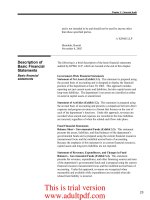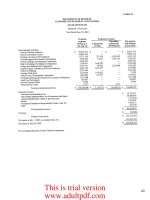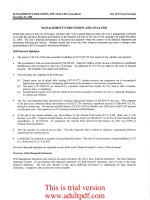Chapter 2: Lack of Planning and Fractured Management Undermine the State’s Tax Collection Efforts_part4 pdf
Bạn đang xem bản rút gọn của tài liệu. Xem và tải ngay bản đầy đủ của tài liệu tại đây (462.3 KB, 11 trang )
38
Chapter 2: Lack of Planning and Fractured Management Undermine the State’s Tax Collection Efforts
Today, seven years after the study, numerous enhancements and
modications have been added to the ITIM system, yet the internal IT
stafng level has remained almost unchanged. Exhibit 2.3 shows the
number of ITS Ofce staff over the past 12 years from 1999 to present.
As shown in the exhibit, the number of internal IT staff increased by
ve between 2003 and 2004, almost to the level recommended by the
vendor’s stafng estimate. Since then, ITS Ofce stafng has steadily
decreased from 25 in 2005 to 20 in 2010.
Long-standing system issues have been unresolved for years
In our analysis, we found that long-standing problems with the ITIM
system have taken years to address or, in some cases, remain unresolved.
We found that these long-standing problems are a result of taking on too
much work with too few resources. Since the completion of the original
ITIM system project, the department has initiated new enhancements and
projects without the required stafng resources to address the increasing
development and testing requirements. In late 2007, the ITS Ofce
identied 18 outstanding problems with the ITIM system. During our
audit work, we noted additional long-standing problems and analyzed
two such problems: unexpected failures of portions of the ITIM system
and mismatches in data between the department’s two accounting
systems.
The ITS Ofce chief stated that the ofce experienced as many as 70
failures a day. These failures, which had been plaguing the ofce since
2002, were associated with the system’s virtual application servers,
which process requests from ITIM system users to update the system’s
database. The ITIM system has 28 such servers shared amongst about
300 tax department users. When a virtual application server fails, the
user is re-routed from the failed server to another one. As a result of the
failures, a user may experience slow response time or may be required
to log in again. The department asserts that the problem was not
signicant enough to affect daily operations. However, the department
Exhibit 2.3
ITS Ofce Stafng Levels
Number of ITS Ofce Staff from 1999 – 2010
1999 2000 2001 2002 2003 2004 2005 2006 2007 2008 2009 2010
13 15 16 16 19 24 25 23 21 21 21 20
Source: Ofce of the Auditor based on data provided by the Department of Taxation and the department’s ITS Ofce
This is trial version
www.adultpdf.com
39
Chapter 2: Lack of Planning and Fractured Management Undermine the State’s Tax Collection Efforts
acknowledged that during 2006 and 2007, the servers were failing faster
than they could be restarted. In November 2008, a representative from
Gartner, an IT research and advisory company, opined that for a system
to fail that frequently is “way out of line.”
The department’s senior management claims that it only became aware
of the issue in Fall 2008, and that once reported, the problem was given a
high priority and resolved by the vendor. For department management to
be unaware of these six-year-old issues raises legitimate concerns about
the department’s oversight of its IT contracts and vendor and reveals, at
the very least, a problem with its identication and prioritization process.
In spite of its claim that it was not aware of the failing application
servers, department management stated that “priority for development
and system testing resources is assigned based on the operational impact
of the problem/issue.” The department said that while the application
server problem created a challenging situation for the internal IT staff,
it was not raised as a priority and, therefore, development and system
testing resources were assigned elsewhere. This explanation reveals a
prioritization process driven by too much work and insufcient stafng
resources.
Another long-standing problem is related to a mismatch in the
transaction data between the department’s tax accounting (TA) system
and its revenue accounting (RA) system. This problem was entered into
the department’s incident tracking log in May 2003. It was not until
2009, however, that the matter was made a priority. That year, 13 data
mismatch entries were added to the tracking log. Of the 13 incidents,
several had balance differences of several hundreds of thousands of
dollars, with the highest difference being in excess of $4.3 million. As of
July 2010, there were 241,753 existing transaction mismatches.
The department lacks the resources to address the problem in a timely
manner. This issue was discussed in the Issues Committee, which met
weekly to discuss concerns related to the department’s IT contracts. In
the minutes of a June 2009 meeting, a department manager emphasized
the importance of addressing the discrepancies by stating that they
should be reconciled monthly by dedicated individuals with the requisite
expertise and knowledge. However, the manager also stated, “With
the various initiatives we are currently tasked with, where does it fall
in the priority list? At the current time, we do not have the bandwidth,
resources, etc., to undertake this initiative.” Over time, the department’s
prioritization of new project related initiatives over the resolution of
existing issues with its systems has resulted in backlogs of problem xes.
Of greater concern is the apparent lack of management oversight of the
department’s IT contracts and vendor.
This is trial version
www.adultpdf.com
40
Chapter 2: Lack of Planning and Fractured Management Undermine the State’s Tax Collection Efforts
Department staff shortages were lled by vendor
The tax department management has allowed the vendor to become
a xed component of its IT system administration and infrastructure.
The department has become dependent upon the vendor’s expertise
and additional personnel to supplement its system administration and
technical support needs. Without a sufcient transition plan to ll the
void left by the departure of its long-term vendor in June 2011, the
department will struggle to support its IT systems and fulll the tax
collection needs of the State.
Several supplemental agreements and contracts put into effect after the
original ve-year 1999 ITIM system project provided vendor production
support hours for the department. Production support hours are hours
for the vendor to provide services on the ITIM system for incidents
and enhancements as determined by the department. They can be used
for a variety of services, including system development, testing, and
analysis. The total number of production support hours made available
to the department from these supplemental agreements and contracts
totaled 48,200 hours. This is equivalent to over 23 years of work for one
employee. At one time, approximately 15-20 vendor staff were working
within the department. Currently, the vendor has ten full-time employees
onsite at the department, and the department has yet to determine how it
will absorb work that has been provided by the vendor.
Department managers conrmed the lack of sufcient internal staff to
complete system testing and reliance on the vendor for assistance. In
spite of concerns by department system administrators, the vendor would
also perform user acceptance testing, meaning that the vendor would test
its own product. In these instances, according to a department manager,
department staff would always review that the job was complete and
satisfactory. Even so, this conicts with best practices that require IT
product testing be conducted by a party other than the product developer.
In addition, the ITS Ofce has the right of rst refusal for IT
development work. If internal IT staff could not complete the job, the
ITS Ofce could pass it on to the vendor. According to the department’s
incident tracking log, the vendor has been assigned 594 incidents
compared to 6,047 for internal IT staff. Based on these assignments, the
vendor assumes about 10 percent of the bug x and system enhancement
development workload.
In addition to stafng, the department also relies upon the vendor for
its technical expertise. In May 2010, the vendor identied work that it
conducts for the department on a recurring basis: production support in
the form of incident and enhancement development work, testing support
to assist the department system administrators, and research and analysis
This is trial version
www.adultpdf.com
41
Chapter 2: Lack of Planning and Fractured Management Undermine the State’s Tax Collection Efforts
support for issues such as tax law changes. The vendor also provided
consulting services to the department for both technical and functional
management decision-support analysis. Given this reliance on the
vendor, we question the ability of the ITS Ofce to maintain the system
after the vendor leaves with its current stafng levels.
The department’s narrow and shortsighted focus on generating revenue
has hindered its ability to strategically manage the long-term effects of IT
initiatives. The department does not have a functional IT strategic plan
and its Act 100 (SLH 1999) report provides no meaningful long-term
strategies and little guidance to fulll the goals of its IT systems. In fact,
the department has no effective department-wide strategic plan.
Since implementing the ITIM system in 1999, the department has spent
about $87 million through its major contracts with CGI. Yet, without
an IT strategic plan that maps out the long-term goals and processes
to assess the accomplishments of its major systems, the department is
unable to demonstrate that the moneys have been spent purposefully
and effectively. The importance of and need for long-term planning by
the department is heightened by the fact that it is the primary revenue-
generating mechanism for the State.
The department does not have an IT strategic plan
The department does not have a strategic plan for its IT systems. We
conrmed with the former director of taxation and other department
managers that there may have been an IT systems strategic plan during
the time of the 1999 ITIM system project, but the department currently
has no formal IT plans. Department management has referred to the
1999 ITIM system contract, service agreement Statement of Work No. 2,
also known as the blueprint report, as the document most similar to an IT
strategic plan.
The blueprint report, which was a contract deliverable, documented the
high-level model of the integration of the vendor’s 1999 ITIM system
project. While this report adequately addressed four key elements of
an effective IT strategic plan—process, organization, technology, and
people—we found that the plan was specic to the 1999 ITIM system
project and has not been updated to address changes in processes,
policies, organizational structures, and other infrastructure components.
Also, because it was a deliverable of the contract and not considered
prior to the contract’s formation, the report does not take into account
cost-related factors.
The DoTAX’s IT
strategic plan is
outdated, narrowly
focused, and
shortsighted
This is trial version
www.adultpdf.com
42
Chapter 2: Lack of Planning and Fractured Management Undermine the State’s Tax Collection Efforts
According to CobiT, a generally accepted internal control framework for
IT, an IT strategic plan should:
Dene, in co-operation with relevant stakeholders, how IT goals •
will contribute to the enterprise’s strategic objectives and related
costs and risks;
Include how IT will support IT-enabled program investments, IT •
services, and IT assets;
Dene how the objectives will be met, the measurements to •
be used and the procedures to obtain formal sign-off from the
stakeholders;
Cover investment/operational budget, funding sources, •
sourcing strategy, acquisition strategy, and legal and regulatory
requirements; and
Be sufciently detailed to allow for the denition of tactical IT •
plans.
The DoTAX management failed to update and implement a meaningful
IT strategic plan after the initial ITIM system project ended. Relying
on CobiT or other IT best practices, the department should develop an
overall IT strategic plan to ensure that the planning for IT systems has
sound goals and objectives and is supporting the overall departmental
goals.
DoTAX has taken an ad hoc approach to IT systems
development
We found that for its 2008 contract and 2009 modication, the
department did not determine the impact of the proposed initiatives,
how IT systems and projects support and align with overall department
business goals, nor assess IT readiness elements. We asked several
DoTAX managers for documentation on the department-wide and
IT strategic planning performed for the 2008 contract and 2009
modication. What we received was documentation that minimally
relates to planning and focuses more on estimated revenue generation
from the initiatives. Moreover, department managers, including the
former director, were not involved with the contract modication.
DoTAX has attempted to implement a strategic plan at annual retreats,
but with no success. The August 2005 and August 2006 agendas
included items that focused on strategic planning, including future
visions, revenue enhancing strategies, and short- and long-term goals and
This is trial version
www.adultpdf.com
43
Chapter 2: Lack of Planning and Fractured Management Undermine the State’s Tax Collection Efforts
objectives, but nothing was formalized thereafter. Similarly, the August
2008 retreat focused on strategic planning basics, including strategic
planning objectives, mission and vision statements, goals, objectives,
action plan, and performance measures. According to some of the
managers, though, only the mission statement was completed.
In early 2009, senior management discussed whether the department
needed a new IT system since the ITIM system project was almost at
the end of its life cycle. The former deputy director worked with a
consultant to gather information and other states’ input. The department
discussed the ITIM replacement system in a presentation for staff. Both
the tax services and processing administrator and the administrative
services ofcer prepared drafts of the ITIM replacement system for
users. However, this project stopped after the former deputy director left.
Thereafter, the successor deputy director, who is now the current director,
did not pursue it; hence, no planning was done.
The Board Brieng on IT Governance, which was developed by the IT
Governance Institute, a not-for-prot organization with a mission to
assist enterprise leaders in their responsibility to make IT successful in
supporting the enterprise’s mission and goals, denes IT governance as
the responsibility of the board of directors and executive management.
It is an integral part of enterprise governance and consists of the
leadership and organizational structures and processes that ensure that
the organization’s IT sustains and extends the organization’s strategies
and objectives. Critical to the success of these structures and processes
is effective communication among all parties based on constructive
relationships, a common language and a shared commitment to
addressing the issues.
The department’s inability to successfully implement a strategic plan and
perform strategic planning for the 2008 contract and 2009 modication
is the result of a lack of leadership. The downturn in the economy and
decrease in tax collections shifted the State’s and the department’s focus
to increasing tax revenue collections.
Transition plan has elements of strategic planning, but lacks
management input and may be too little, too late
Senate Concurrent Resolution No. 78, SD 1, of the 2010 legislative
session requested that DoTAX establish and implement a transition plan
where DoTAX will assume all functions performed by CGI for the 2009
modication. During a June 2010 Ways and Means (WAM) Committee
informational brieng, DoTAX submitted a draft transition plan prepared
by the ITS Ofce. As of November 2010 (and now long overdue), the
department is still working to develop this transition plan, calling into
question management’s effectiveness to plan strategically.
This is trial version
www.adultpdf.com
44
Chapter 2: Lack of Planning and Fractured Management Undermine the State’s Tax Collection Efforts
The draft transition plan appears to have been the result of SCR 78,
SD 1, and driven by a need to transition to the next administration rather
than a self-initiated DoTAX process performed periodically to address
long-term needs. In testimony provided during the WAM informational
brieng, the director stated that it has been his experience that transition
plans are normally prepared when there is a transition from one
administration to the next. The ITS Ofce chief stated that while he has
been tasked to write the transition plan for SCR 78, SD 1, he has not
collaborated with other DoTAX management and has left sections for the
Compliance and Tax Services and Processing Divisions to complete.
According to CobiT, the IT strategic plan should dene, in cooperation
with relevant stakeholders, how IT goals will contribute to the
enterprise’s strategic objectives and related costs and risks, and should
include how IT will support IT-enabled program investments, IT
services, and IT assets. It should also cover investment/operational
budget, funding sources, sourcing strategy, acquisition strategy, and
legal and regulatory requirements. The draft transition plan we reviewed
included the following key areas: 1) future contracts; 2) transition
of current implementations by current vendor; 3) legislative and
departmental initiative funding planning; and 4) budget transition
planning. We note, however, that as of November 2010, the plan was not
yet complete. Lacking a completed transition plan and the involvement
of all responsible managers, the budget to hire more internal IT staff, and
the skill and knowledge to program proprietary code, it is unlikely that
the department will be able to continue maintenance and enhancement of
its IT system without difculty.
According to the former deputy director, consideration for the transition
away from dependency on CGI was built into the 2009 modication
via knowledge transfer initiatives; however, this may have been too
little, too late. The former deputy director stated that transition was not
heavily emphasized in the 2008 contract where the focus was on revenue
generation, but was included in the 2009 modication. Although there
had been talk about knowledge transfer from CGI to the ITS Ofce
throughout her term, internal IT staff turnovers, especially departures of
key people, has made transition difcult.
The Department of Taxation is the State’s primary revenue generating
entity. Therefore, the success of its tax collection functions is of
critical importance to the well-being of Hawai‘i’s residents. However,
a lack of planning and insufcient resources to support a growing IT
infrastructure threaten to cripple these important systems. To meet these
and other challenges, the department must rst wean itself from a vendor
which it has grown dependent on for essential services. Secondly, as it
Conclusion
This is trial version
www.adultpdf.com
45
Chapter 2: Lack of Planning and Fractured Management Undermine the State’s Tax Collection Efforts
prepares for a new administration and new leadership, it must overcome
the internal strife that resulted from its vendor relationship. Finally,
and most importantly, DoTAX must begin an IT strategic planning
process that establishes long-term goals and strategies and enables the
department to operate effectively, efciently, and independently.
The Department of Taxation needs effective leadership to take a stronger
role in the overall planning and management of its IT systems. It
also needs to attend to practices and problems that eroded working
relationships among employees and the vendor by managing various
intra-agency factions and training staff in project management skills
to properly maintain and upgrade increasingly important information
systems.
The Department of Taxation should: 1.
a. Develop and implement an effective IT strategic plan to guide
the department’s efforts to sustain and extend department-wide
strategies and goals and ensure the plan addresses the four key
elements of process, organization, technology, and people;
b. Discontinue any further enhancements to the IT system unless
required by law until the department’s needs and priorities are
addressed through IT strategic planning;
c. Ensure the transition upon the completion of the 2009
modication is completed and results in a sustainable and
ongoing support and maintenance of its IT systems; and
d. Better manage its future IT systems by establishing an adequate
project and contract management methodology and ensuring
project management is competent to hold vendors accountable.
With regard to the department’s management conicts, the 2.
department should:
a. Tackle the root cause of problems impeding the department’s
performance. A cultural transformation will be the key to the
department’s success. The existing culture of hierarchical
management approaches will need to yield to one of partnerships
among managers; process-oriented ways of doing business will
need to yield to results-oriented ones, and organization “silos”
will need to become integrated.
Recommendations
This is trial version
www.adultpdf.com
46
Chapter 2: Lack of Planning and Fractured Management Undermine the State’s Tax Collection Efforts
b. Improve its performance by altering the way department leaders
and managers treat each other and manage their people, as well
as building commitment and accountability through involvement
and trust. Effective changes can only be made and sustained
through the cooperation of management and staff throughout the
department.
During our audit we were hampered in our review of documentation 3.
due to taxpayer condentiality issues. The Legislature should
consider amending the department’s statutes to coincide with the
Internal Revenue Code to allow state audit agencies authorized under
the laws of the State to audit state revenues and programs.
During our audit we encountered areas of concern that were out of our
scope but we considered signicant to warrant further study.
Issues raised in the IRS safeguard review audit
In March 2009, the U.S. Department of Treasury Internal Revenue
Service conducted a safeguard review of the DoTAX under Sections
6103(d) and (I)(10), Internal Revenue Code. The review was limited to
the safeguards used to protect the condentiality of federal tax returns
and return information as applicable to the DoTAX. We reviewed the
safeguard review audit report and noted that a signicant portion of the
audit ndings and recommendations were related to computer security
(80 pages of the 95 page report). The audit included an evaluation of the
management, operational, and technical controls safeguarding federal tax
information. Findings are grouped under headings such as management,
operational, and technical controls. Because the audit reported a
signicant number of ndings related to IRS data and how they were
being handled, and because it included more than 70 ndings concerning
procedures and general processes, we deem this signicant enough to
warrant further study.
ITIM system general and application control issues
During our audit work, we encountered concerns over general and
application control issues related to the ITIM system. For example:
1) the ITIM Tax Processing system does not have a cash control account,
and thus bank reconciliations cannot be performed and the state revenues
collected cannot be veried; 2) controls are not in place to ensure manual
adjustments to the system are approved and veried; and 3) there is an
inadequate timeframe within which to address and resolve incidents
and problems of all severity levels. We could not determine the actual
number of incidents that remain unaddressed and unresolved because
Issues for Further
Study
This is trial version
www.adultpdf.com
47
Chapter 2: Lack of Planning and Fractured Management Undermine the State’s Tax Collection Efforts
the department did not provide us access to the data due to taxpayer
condentiality. Until the law regarding access to condential taxpayer
information is amended, however, this issue cannot be addressed.
Revenue accounting table information
We also encountered concerns over the delete/archive initiative, in which
information in the revenue accounting table may be inappropriately
deleted. Because this concern was beyond the scope of our audit, we did
not delve further into this topic but would recommend it as an issue for
further study.
This is trial version
www.adultpdf.com
This page is intentionally left blank.
48
Chapter 2: Lack of Planning and Fractured Management Undermine the State’s Tax Collection Efforts
This is trial version
www.adultpdf.com









